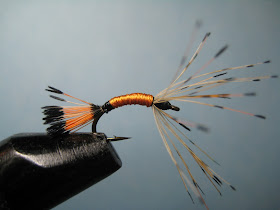 |
| Golden Pheasant |
I like to tie classic wet flies. I don't fish with them but I really do enjoy tying them. I think of them as miniature works of art and many of them have interesting histories attached to them. Some classic wet flies, such as the Royal Coachman and Grizzly King, are still used today. The Golden Pheasant is a pattern that goes back to at least the mid 1800's. The Golden Pheasant is described in Mary Orvis Marbury's book,
Favorite Flies and their Histories. In this book she describes another work by a Mr Wells who did various experiments in a water tank to examine the properties of the feathers from a golden pheasant. He came to the conclusion that in addition to the durability and delicacy of the feathers, that they had the best properties with regard to the way that light interacts with them over any other type of fly tying material.Golden pheasants were bred to get just the right color to attract salmon and trout most effectively. I'm hoping to utilize these qualities with my next little creation which I call a Golden Sakasa Kebari. I have to admit the idea for this one came from several places, one being the classic wet fly above (which is not tied as well as I would like). The other idea came from a fly I saw some time ago on-line. Unfortunately, I can not remember the tier's name or that of his fly to give him full credit, but it was good looking fly. It had a purple body and golden pheasant hackle that was tied in the fashion of a traditional soft hackle. For my fly, I have tied it with and without he tail. I think it makes a nice looking fly and I can't wait to try out it's effectiveness. In the meantime, I have a recipe and photo below for anyone who wants to take a look.
 |
| Golden Sakasa Kebari |
Golden Sakasa Kebari
Hook: Mustad C49S
Thread: Black Uni-Thread 6/0
Body: Pearsall's hot orange silk thread
Tail: golden pheasant tippets (optional) probably should use fewer than in the pic.
Hackle: small golden pheasant feather


Wow. Love it!
ReplyDeleteTroutrageous, thanks!
ReplyDelete